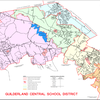GCSD drafts $120 million budget for next year, up 9 percent but still under tax cap
GUILDERLAND — The school district here has drafted a $119,767,153 budget for next year, roughly $10 million more than this year’s spending plan, or a 9-percent increase.
It preserves existing programs for students as well as social and emotional support as federal funds provided during the pandemic are being used up.
The estimated tax levy increase, at 2.76 percent, stays under the state-set limit, requiring only a simple majority to pass the budget on May 16. The budget draft shows Guilderland’s spending is $195,000 below the state-set cap.
“We’re compelled to address a number of pretty significant increases that we can’t control,” Superintendent Marie Wiles told the school board as she presented the draft at the board’s March 7 meeting.
She named transportation that the district has had to contract out because of a shortage of bus drivers, health-insurance increases, and having to pay “large tax refunds” because businesses have successfully challenged town assessments.
“We also want to respect our taxpayers,” Wiles went on, “which is why you don’t see us going all the way up to the tax cap; we’re trying to be mindful of, you know, how much our taxpayers in this community are chipping in already to support the important work we do.”
Guilderland’s state aid, according to the governor’s budget, is increasing an unprecedented 22.8 percent for next year, up about $7 million to $37.5 million.
State and federal aid together is to account for about $37.8 million while property taxes are to pay for about $80 million, up about $2 million from this year.
The influx, said Andrew Van Alstyne, Guilderland’s assistant superintendent for business, comes at a “very fortuitous time because we have some very rising expenses that are almost fully out of our control.”
However, he noted that just over a half-million dollars in what was supposed to be fully restored Foundation Aid, is to be carved out for what Governor Kathy Hochul has termed “high impact tutoring.”
Wiles is hopeful that the State Legislature, which by law is supposed to finish budget negotiations by April 1, will allow districts to spend those carved-out funds in ways that instead meet each district’s needs.
Costs
As with any school budget, the lion’s share of expenditures — 77.5 percent — is for salaries and benefits.
Guilderland currently has 4,918 students who are attended to by 954 employees: 510 teachers, 418 support staff, and 26 administrators.
Salaries for professionals, the draft says, total about $49 million, up more than $2 million from this year.
Salaries for support staff total close to $12 million, up about half-of-a-million dollars from this year.
Contract salary increases make up about 20 percent of the budget hike.
Employee benefits total $29.5 million, up $1.3 million from this year.
Van Alstyne went over seven increases that he termed “significant cost drivers,” which together make up about 63 percent of the year-over-year increase:
— $2.6 million in capital borrowing that he said would “be balanced out by state aid”;
— $1.4 million in tax certiorari claims, which the district “would have to borrow to fund paying back judgments against us if … all of the cases do not work out well.” Last year, the district exhausted it reserve for the refunds;
— $1.3 million increase in health-insurance costs, which Van Alstyne attributed, in part, to people not going to doctors during the pandemic, leading to the current rebound;
— $560,000 more for contract transportation, mostly for students with disabilities but also for homeless and foster-care students;
— $97,000 for professional services associated with students who have disabilities; and
— $80,000 in increased legal expenses, again related to assessment challenges.
Priorities
Wiles began her presentation by reporting on the robust response to an online anonymous ThoughtExchange that allowed parents, faculty and staff, and students to state their priorities; school board members were surveyed separately.
Parents and staff both had the same top priority: school safety and controlling disruptive behavior.
Parents next listed hiring an additional school resource officer. One SRO had been stationed in the high school and, starting with the new year, a second was added at the middle school. The second officer was approved by the school board as a pilot program, paid for by the town through the Guilderland Police Department, until the end of the school year.
The parents’ third choice and the staff’s second was to maintain or lower class sizes.
Parents also wanted to improve school lunches and, finally, close learning gaps for students.
Staff wanted increased salaries for teaching assistants and more teaching-assistant positions. Wiles said, just as with bus drivers, teaching assistants are in short supply and that the district has been unable to fill vacancies.
Staff also wanted increased emphasis on mental health and social and emotional well being and, finally, staff wanted to improve student learning with a focus on literacy.
Meanwhile, the students’ first priority was to improve wi-fi and have fewer online sites blocked by the school. Wiles said blocking sites was a safety measure.
Students wanted improved bathrooms, which Wiles said was being addressed by the capital project, and improved school lunches with more choices.
Students also wanted lockdown procedures explained; Wiles said a video on this had been made at the high school.
Finally, students wanted to recognize more holidays on the school calendar. Wiles said that, for the next school year, Eid will be a school holiday; Eid al-Fitr marks the end of Ramadan, the Muslim holy month of fasting.
The board’s top priority was maintaining current programs and services, which the draft budget does, followed by focusing on student and staff mental health and building respect for all.
The board also wants to reduce class size at Farnsworth Middle School, an initiative that started last year and is part of the current budget. Two sections were added to the eighth grade, going from 14 to 16, so that the average eighth-grade class size is now 23.
The average class size for sixth-graders is 28 and for seventh-graders is 26.
For next year, the budget proposes moving to 16 sections for six and seventh grades, which means adding four core teachers — in math, science, social studies, and English — as well as part-time posts in other subjects. This would cost $525,600.
The draft also calls for a permanent school resource officer at the middle school for $56,000.
Another safety-related addition is $30,000 for lead testing to be completed by 2025.
“We have new standards to meet around testing for lead,” said Wiles. “They have lowered the standard to five parts per billion to 15 parts per billion. We have 72 outlets across the district that fall within that area that we need to do testing and likely remediation. The $30,000 is an estimate of what that will cost in order to do that.”
Pre-kindergarten
The governor’s budget includes what Van Alstyne described as “a significant expansion of universal pre-kindergarten funding.”
He explained, “This is funding that is based on a number of slots, and each district has a predetermined number of slots and associated funding of those slots. Because of this, it is very unlikely that we will be able to accommodate the number of slots that we would theoretically have funding for.”
A lottery will be held to determine which children get the paid-for slots, which, because the district doesn’t have room in-house, are at four local venues: All Saints Catholic Academy, Christ the King Early Childhood Learning Center, Kids’ Corner Childcare and Learning Center, and Saint Madeleine Sophie School.
Later in the meeting, Rachel Anderson, Guilderland’s assistant superintendent for curriculum and instruction, said that parents wishing to apply for a pre-kindergarten spot have to fill out a form between March 13 and April 6.
Any student who turned 4 years old before Dec. 1 is eligible.
“This upcoming school year, we are mandated by the state to do a lottery selection process to fill our UPK slots,” said Anderson of universal pre-kindergarten. “So we’ll be doing that once the registration window closes.”
The same four sites as were used this year will be used again next year, Anderson said. “It’s looking like we will have between 90 and 110 seats,” she said, noting there had been 110 but one of the sites may drop a section.
DEI
Wiles opened her presentation by reciting the district’s mission statement with the emphasis on “all”: It shall be the mission of the Guilderland Central School District to inspire all students to be active lifelong learners, able to achieve their highest potential in a demanding and ever-changing global community.
“We have a renewed commitment to recognizing and affirming each and every one of our children,” Wiles said, “regardless of their wealth, their poverty, their race, their religion, their culture, their language, their gender, their gender identity — each and every child matters to us.”
Towards the end of her presentation, Wiles said one of her favorite proposals of the whole budget was $2,500 to start a unified bocce team, to pay for a coach and equipment. The unified teams include athletes with disabilities.
The new bocce team, Wiles said, would “make it possible for our unified teams to have a sport in all three seasons. So now you know where my biases are.”
The budget draft also includes one-and-three-tenths of a teaching post for English as a new language at a cost of $109,200 to meet continued needs of elementary students; this was previously funded by a grant.
Fifty-three languages are spoken by students in the Guilderland schools.
Finally, the draft includes a teacher on special assignment, for $84,000, to help the district’s director of diversity, equity, and inclusion, Matthew Pinchinat.
This would be paid for through federal funds next year, Wiles said.
“Just yesterday,” she said, “our seven equity teams presented their equity action plans after working for several months now with Natalie McGee and Progression Partners; there is a ton of work that is now spelled out in these plans. And Matt cannot do them all; he can’t do all of that himself, even with the members of the team pitching in to do it. So we'd like to try this model … for a year with the grant dollars and see how it goes.”
Later in the meeting, Wiles said of Pinchinat, “In the interest of full transparency, he had asked for secretarial help. But … when he listed what he needed help with, it’s someone else to go out to schools to teach model lessons, to do PD,” she said of professional development, “to meet with students who are wanting to talk, to meet with teachers who want help with their lessons, to meet with librarians to help them think about their collections. That’s an instructional person.”
“I’m so glad that was added,” said school board member Blanca Gonzalez-Parker.
Board member Nathan Sabourin said of a draft of a new anti-racism policy, “There is a lot of potential work that’s going to be added to Matt’s ledger. So I would say this is somebody that’s going to be dearly needed.”



